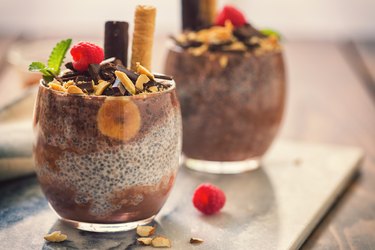
From making a cameo in everything from pudding to kombucha to energy bars, chia seeds have had more than their 15 minutes of fame over the past decade or so. But it appears there's a "new" seed looking to steal the limelight. Basil seeds have been gaining steam, thanks to their stellar nutritional profile that rivals chia seeds'.
Basil seeds are a beloved "superfood" thanks in part to their rich nutrient-profile but also their unique culinary application — they create a gel when combined with water.
Video of the Day
Video of the Day
Read more: How to Use Chia Seeds for Weight Loss
Why Should You Stock Up on Basil Seeds?
Basil seeds look a lot like chia seeds — they're tiny and black — but they come from the sweet basil plant (Ocimum basilicum) that we usually use to garnish cheesy dishes. Like chia seeds, they also become gelatinous after soaking in liquid although they plump up more quickly. And while they might be becoming more popular now, the seeds, along with the entire sweet basil plant, have long been used in Ayurvedic and Unani systems of medicine.
Aside from their gelling powers, chia seeds are lauded for their fiber content. But that's where basil seeds outshine, and then some. "Basil seeds have zero net carbs and almost twice as much fiber, potassium, iron and calcium as chia seeds," Tanya Zuckerbrot, RD and CEO and founder of F-Factor, tells LIVESTRONG.com.
One tablespoon of chia seeds contains:
- 60 calories
- 3.5 grams total fat (0 grams saturated fat)
- 5 grams carbohydrates (4 grams fiber, 0 grams sugar)
- 2 grams protein
- 2,880 milligrams omega-3s
The same serving size of basil seeds contains:
- 60 calories
- 2.5 grams total fat (0 grams saturated fat)
- 7 grams carbohydrates (7 grams fiber, 0 grams sugar)
- 2 grams protein
- 1,240 milligrams omega-3s
"Basil seeds are also rich in plant compounds including flavonoids and other polyphenols which have anti-inflammatory properties and are a prebiotic, so they can help repopulate the microbiome," says Zuckerbrot.
Prebiotics are fibers that help create a beneficial environment in your gut for bacteria to grow, according to the Academy of Nutrition and Dietetics. Because of this, they help "set the stage" for probiotics, making prebiotics vital when it comes to how well these good bacteria flourish. And since most Americans don't get enough fiber in their diets, basil seeds are an easy way to fill in that gap.
However, while basil seeds are a good source of omega-3 fats, chia seeds have more than double the amount of the inflammation-fighting fat.
9 Ways to Enjoy Basil Seeds
The good thing about basil seeds is that, because their texture and subtle flavor is similar to chia seeds, you can use them in the same way. "You can blend into smoothies or use in baked goods, like 20/20 waffles, 20/20 pancakes and 20/20 muffins," offers Zuckerbrot. "Just be sure to soak them first!"
Here are nine tasty ways to try basil seeds:
1. As a binder in meatballs: Looking for a gluten-free or paleo-friendly option for binding meatballs while also bumping up the fiber and nutrient profile? Skip the bread crumbs and use gelled basil seeds instead.
2. The base for pudding: The great thing about basil seeds (aside from the awesome fiber content) is that they have a subtle flavor so they really take on the flavor of whatever you're adding to the dish. Use them as a base for pudding, and add cacao powder, fresh berries and a light drizzle of honey or maple syrup.
3. Thicken your smoothies: Not only will the thickened smoothie taste more satisfying, but the filling fiber will add bulk, keeping you fuller longer. For only 60 extra calories, a tablespoon of basil seeds will add a whopping 7 grams of fiber.
4. Make your own high-fiber wrap: A little more labor-intensive but worth the effort. For this one, grind the seeds first and then gel before combining with the other ingredients in this recipe.
5. Layer a yogurt parfait: The thing with yogurt parfaits is that they're typically high in added sugar and low in fiber. Let the basil seeds gel and then mix in with Greek yogurt and then top with fresh berries for a healthy homemade version.
6. DIY jam: Jams and jellies are typically high in added sugar. Upgrade your jam by making your own with just fruit and basil seeds or add a little sweetener if you like.
7. Make sticky fried rice: Using gelled basil seeds brings the "sticky" to fried rice. You can also try a mix of regular rice and riced cauliflower to get in more veggies and lower the carb count.
8. Crusted fish swap: Another healthier option over traditional bread crumbs, basil seeds can be swapped in with your favorite herbs and spices to crust fish and any other meats.
9. Healthy bagel swap: You can make your own bagels at home and give them a healthier spin by incorporating ingredients like cauliflower, chickpea flour and nuts and seeds. Basil seeds help to keep this bagel together giving it that texture you love. Try this mini cauliflower bagel recipe.